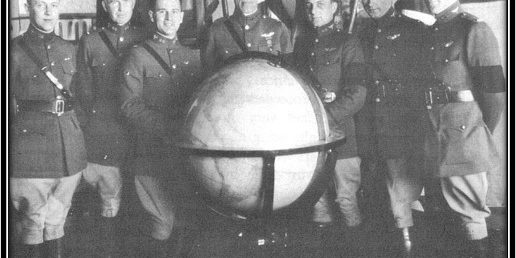History on September 26 in 1580, 1924, and 1996: An Aviation History Threefer
Contributor: Barry Fetzer
Sources: History.com, Wikipedia, NASA, USAF Historical Research Center, and National Air and Space Museum
Everyone loves a bargain. I got a BOGO at Harris Teeter here in Southern Pines yesterday on our favorite Greek yogurt and felt like I had scored a real deal! And today we have a three for the price of one history vignettes!
Navigation is an integral skill and ability for aviators. “I’m not lost. I’m just temporarily disoriented.” is a common refrain (that I’ve used myself) amongst aviators who, like me, have been completely lost and hopelessly disoriented due to failing at the basic skill of navigation.
And most aviators are taught the following three most important jobs of a pilot: “Aviate, navigate, communicate”, navigating being the second most important job of a pilot.
And Sir Francis Drake had extraordinary success in navigation, even around the world.
According to History.com, “On September 26, 1580, English seaman Francis Drake returned to Plymouth, England, in the Golden Hind, becoming the first British navigator to sail the earth and accomplishing this almost two hundred years before a precise means of determining longitude was finally invented in 1762.

Sir Francis Drake photo by Stock Montage/Getty Images
On December 13, 1577, Drake set out from England with five ships on a mission to raid Spanish holdings on the Pacific coast of the New World. After crossing the Atlantic, Drake abandoned two of his ships in South America and then sailed into the Straits of Magellan with the remaining three. A series of devastating storms besieged his expedition in the treacherous straits, wrecking one ship and forcing another to return to England. Only the Golden Hind reached the Pacific Ocean, but Drake continued undaunted up the western coast of South America, raiding Spanish settlements and capturing a rich Spanish treasure ship.
Drake then continued up the western coast of North America, searching for a possible northeast passage back to the Atlantic. Reaching as far north as present-day Washington before turning back, Drake paused near San Francisco Bay in June 1579 to repair his ship and prepare for a journey across the Pacific. Calling the land “Nova Albion,” Drake claimed the territory for Queen Elizabeth I.
In July, the expedition set off across the Pacific, visiting several islands before rounding Africa’s Cape of Good Hope and returning to the Atlantic Ocean. On September 26, 1580, the Golden Hind returned to Plymouth, England, bearing its rich captured treasure and valuable information about the world’s great oceans. In 1581, Queen Elizabeth I knighted Drake during a visit to his ship. The most renowned of the Elizabethan seamen, he later played a crucial role in the defeat of the Spanish Armada. The explorer died 1596 at the age of 56.
And it took another 344 years before the same feat was accomplished in the air. According to the National Air and Space Museum, “On April 6, 1924, eight U.S. Army Air Service pilots and mechanics in four airplanes left Seattle, Washington, to carry out the first circumnavigation of the globe by air. They completed the journey 175 days later on September 28, 1924 after making 74 stops and covering about 27,550 miles.

United States Air Force Historical Research Center, Office of Air Force History, United States Air Force, Washington, D.C.
“The airplanes were named for American cities and carried a flight number: Seattle (1), Chicago (2), Boston (3), and New Orleans (4). They flew over the Pacific, Indian, and Atlantic oceans and encountered climatic extremes from arctic to tropical. Only the Chicago, flown by Lts. Lowell Smith and Leslie Arnold, and the New Orleans, flown by Lts. Erik Nelson and John Harding Jr., completed the entire journey.”
And by the way and not really a part of our threefer but worth mentioning from the perspective of considering how long it took to circumnavigate the globe on the surface of our Earth to doing it in the air and then how little time it took to circumnavigate the globe from space. It was only 37 years after the first flight around our “Pale Blue Dot” (as Carl Sagan described a photograph of Earth taken on February 14, 1990, by the Voyager 1 space probe from an unprecedented distance of approximately 6 billion miles away) on April 12, 1961, that Russian Lt. Yuri Gagarin became the first human to orbit Earth in Vostok 1.
And today in 1996, the third item in our threefer, according to History.com, “U.S. astronaut Shannon Lucid returned to Earth in the U.S. space shuttle Atlantis following six months in orbit aboard the Russian space station Mir.

Shannon Lucid, in 2004. Courtesy NASA.
“On March 23, 1996, Lucid transferred to Mir from the same space shuttle for a planned five-month stay. A biochemist, Lucid shared Mir with Russian cosmonauts Yuri Onufriyenko and Yuri Usachev and conducted scientific experiments during her stay. She was the first American woman to live in a space station.
“Beginning in August, her scheduled return to Earth was delayed by more than six weeks because of last-minute repairs to the booster rockets of Atlantis and then by a hurricane. Finally, on September 26, 1996, she returned to Earth aboard Atlantis, touching down at Edwards Air Force Base in California. Her 188-day sojourn aboard Mir set a new space endurance record for an American and a world endurance record for a woman.
According to Wikipedia, “Lucid retired from NASA to care for her husband, Mike, who had dementia. He died on December 25, 2014. She later wrote about this experience in her book No Sugar Added: One Family’s Saga of Dementia and Caretaking (2019).”
Onward and upward!
Sources: History.com, Wikipedia, NASA, USAF Historical Research Center, and National Air and Space Museum







